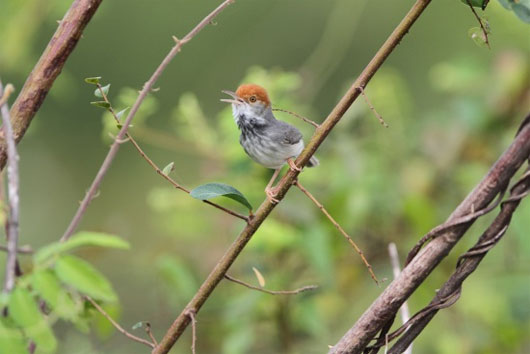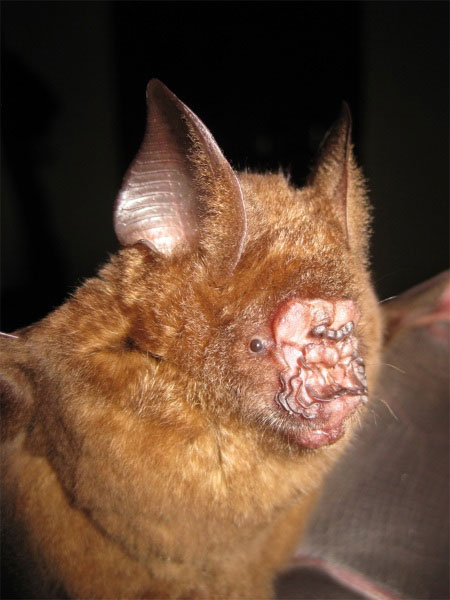More new species discovered in the lower Mekong
The giant flying squirrel, flying gecko, head mating fish and an eyeless spider living in the cave are some of the 367 new species discovered by scientists in the Greater Mekong Sub-region in 2012-2013, and described in the new WWF report: Mysterious Mekong.
The report, published by WWF on World Environment Day, introduces many species not only strange but also beautiful. Among the 15 species described in the report are flying squirrels (Biswamoyopterus laoensis), discovered at a market selling wild meat in Laos. With characteristic red and white fur, the giant Lao flying squirrel marks the existence of a branch of their flying squirrels in Southeast Asia.
In Cambodia, a new species of warbler found in a lawn between the capital Phnom Penh. The Cambodian Warblers (Orthotomus chaktomuk) was first discovered in 2009 while performing a routine bird flu screening program. Later experiments, from their fur, their songs to their genes, confirmed that this is a new species.

Cambodian cotton warbler (Orthotomus chaktomuk).Photo: James Eaton / Birdtour Asia.This bird has a small, agile body, dark gray fur and orange red hairs on its head.This species mostly inhabits dense bush populations in the Mekong floodplain, next to Phnom Penh.
'Newly discovered species confirmed the Greater Mekong Subregion as one of the richest and most biodiverse regions in the world' - Dr. Thomas Gray, WWF Species Program Manager- Greater Mekong speaks. 'If we want to protect these new species from extinction and raise hope to find other unique species in the future, the important thing to do right now is the investment governments. into green conservation and development strategies ".
In Vietnam, a bizarre bat species was first seen on Cat Ba Island in 2008. However, it took some time later, when a group of researchers caught some more individuals, they Newly identified as a completely new species. The leaf-nosed Grifin bat (Hipposideros griffin) is identified by an odd meat nose that assists them in echolocation, similar to the ability to use ultrasound to help them move.

Bat nose Griffin leaves (Hipposideros griffini).Photo: Vu Dinh Thong / Hanoi Institute of Ecology and Biological Resources.This species was found in 2012, has a bizarre nose, which supports echolocation to move.This species was found at 248m above sea level at Cat Ba National Park on Cat Ba Island in Ha Long Bay in northern Vietnam, and both Chu Mom Ray National Park is located on land more than 1000km away. southern.This bat species is found in forests with human hands and primary forest.
Also in Vietnam, a tiny and almost transparent fish, with a very complicated anatomical mechanism has been discovered. Phallostethus cuulong has a reproductive organ located just below the mouth. They mate with each other, with the male reproductive organs hook into the female reproductive organs.
Among the 21 new species of amphibians recorded in the report, there was the Helen flying frog (Rhacophorus helenae) discovered only less than 100km from Ho Chi Minh City. This large green frog is not in the reach of biologists until now thanks to surfing between the tops of trees with large limbs and membranes; and they just jump down to reproduce in the rain pools. The discovery of Helen's frog species in a forest flap in the middle of agricultural lands underscores the urgency of preserving lowland forests.

Giant green frog knows how to fly (Rhacophorus helenae).Photo: Jodi JL Rowley / Australian Museum.This frog species can be up to 10cm long and belongs to a group of frogs with the best flying ability
'Lowland tropical forests are among the most threatened areas by human activities such as logging or degraded environmental activities,' Dr. Gray added. 'Although Helen's frog has just been discovered, this species, like many other species, has been threatened by the increasingly narrow habitat.'
A new species with high flying ability is the parachute (Ptychozoon kaengkrachanense), discovered in the evergreen forest in Thailand's western mountains Kaeng Krachan National Park. Gecko species with this camouflaged skin can stretch the skin on the flanks and between the toes to plunge from the branches to the trunk.
"Kaeng Krachan National Park is one of the least explored areas in Southeast Asia. This is a wild area near the border with Myanmar," said Dr. Gray. An important role in species restoration in Thailand and Myanmar, there is one of the world's largest tiger populations, the discovery of new species here confirms the importance of WWF's conservation efforts. and partners in this wonderful natural area '.
In a cave in Laos, Dr. Peter Jäger discovered a new hunter spider (Sinopoda scurion) and also the first spider in the world without eyes. The depiction of the eye in this spider is because they live entirely in a light-free environment.
- Find more than 1,000 new species in the Mekong Subregion
- 139 new species were discovered in the Mekong region
- Discovered 163 new species in the Mekong region
- The dam will make the Mekong catfish extinct
- Discovering many new species in Vietnam
- Disaster management for the Lower Mekong countries
- No decision has been made on Lao hydroelectric dam
- Discovered a dragon-like lizard
- Discovered 3 new animals in Vietnam
- Many measures to prevent forest fire
- Protection of mangrove ecosystem in Mekong Delta
- Successfully breeding many freshwater fish species
 Animal 'suffering' after hibernation
Animal 'suffering' after hibernation Why do goats climb well?
Why do goats climb well? Scientists were surprised to see chimpanzees eating turtles
Scientists were surprised to see chimpanzees eating turtles Giant catfish died deadly due to drought in Thailand
Giant catfish died deadly due to drought in Thailand